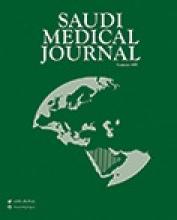Abstract
Objectives: To describe the clinical characteristics of pediatric patients colonized or infected by Stenotrophomonas maltophilia (S. maltophilia) at a Saudi children’s hospital, to identify risk factors associated with infection, and to investigate the antimicrobial resistance patterns of this emerging pathogen.
Methods: In this cross-sectional observational study, 64 non-duplicating S. maltophilia strains were isolated in Najran Maternity and Children’s Hospital, Najran, Saudi Arabia between January 2015 to February 2016. Antimicrobial susceptibility testing was performed using the reference broth microdilution method.
Results: In this study, 48 (75%) isolates were identified in true infections and 16 (25%) isolates were considered colonization. The main types of S. maltophilia infection were pneumonia in 22 (45.8%) patients and bloodstream infection in 14 (29.2%) patients. The significant risk factors included exposure to invasive procedure (p=0.02), and presence of acute leukemia as an underlying disease (p=0.02). The most active antimicrobials were trimethoprim/sulfamethoxazole (100% sensitivity) and tigecycline (93.7% sensitivity).
Conclusions: Stenotrophomonas maltophilia is an emerging nosocomial pathogen among pediatric patients. Accurate identification and susceptibility testing of this emerging pathogen are crucial for the management of infected patients and prevention of spread of this nosocomial pathogen.
Footnotes
Disclosure. Authors have no conflict of interests, and the work was not supported or funded by any drug company.
- Received September 8, 2016.
- Accepted February 15, 2017.
- Copyright: © Saudi Medical Journal
This is an open-access article distributed under the terms of the Creative Commons Attribution-Noncommercial-Share Alike 3.0 Unported, which permits unrestricted use, distribution, and reproduction in any medium, provided the original work is properly cited.






